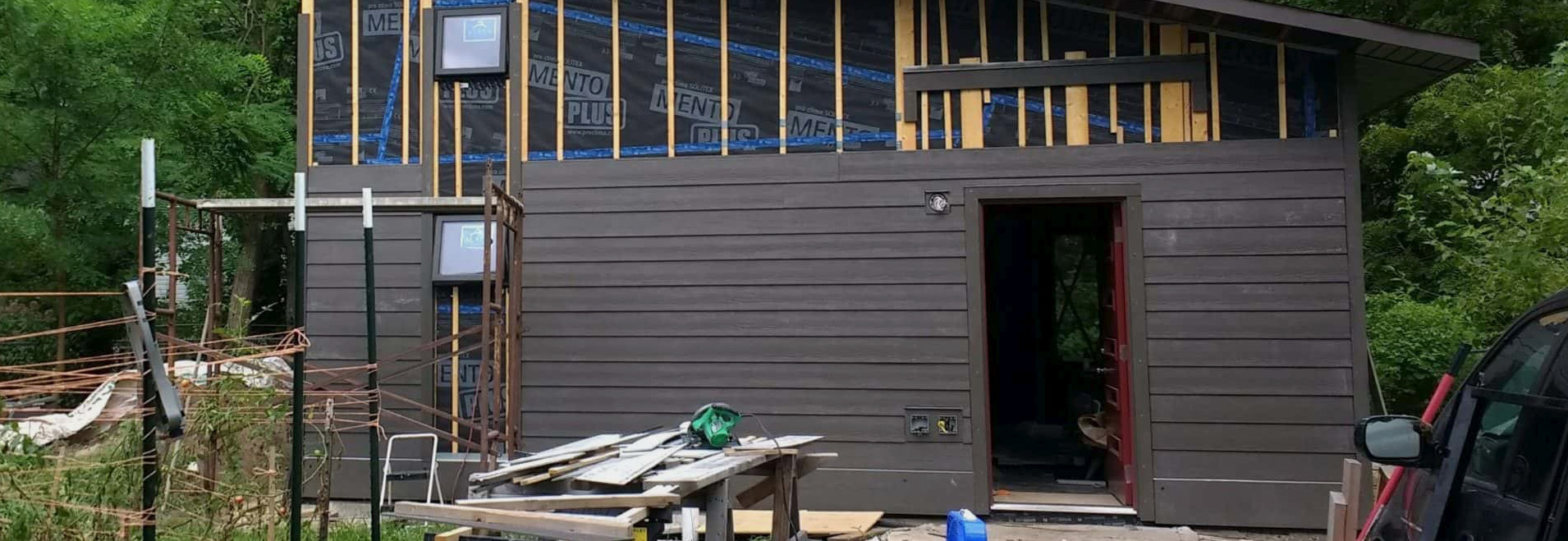This article uses vocabulary that may be unfamiliar to those not versed in natural building. For reference, a glossary of terms is provided at the end of the article. An asterisk (*) indicates inclusion in the glossary. Interviews have been edited for brevity and clarity.
A group of mid-Missourians are rethinking residential architecture for a more natural, affordable kind of urban home. Their favored building material? Straw. Now, this is not the easily huffed-puffed-and-blown-down straw house of the three little pigs. Rather, these straw bale houses are exceptionally airtight, well-insulated, and thermally massive (see “Ask Tommy” sidebar), making them particularly energy efficient as well as carbon-sequestering*. Columbia, Missouri, changemakers Adrienne Stolywk and Tommy Fieser (the author’s brother) are among this group of passionate people embarking on a journey to build these houses within city limits, though they are most often found in rural areas without building codes. Now that their first in-town natural building* project (an accessory dwelling unit* in Adrienne’s backyard) is operational, Adrienne and Tommy spoke with me about their natural building inspirations, experiences, and plans for the future.
Meet the Builders
Adrienne Stolwyk is a licensed architect in Columbia, Missouri, who is at the forefront of natural building compliant with city code. She is especially interested in net zero* buildings—that is, those built with carbon-sequestering materials and designed to consume minimal energy throughout their lifespans. Adrienne got her start with straw bale construction*, a type of natural, carbon-sequestering architecture, during a summer internship with the Lama Foundation near Taos, New Mexico, overlooking the hazy bluish Sangre de Cristo Mountains. While she plastered rustic houses with the same reddish clay on which they stood, Adrienne began to wonder how the natural building techniques practiced at the remote Foundation could be applied in a city, where building codes must be followed.
That experience at the Lama Foundation sparked something in Adrienne that she carried into the final semesters of her 5-year architecture degree and beyond. During the conversation excerpted in this article, Adrienne remarked that, while straw bale is a legitimate building methodology, “it’s happening on the fringes and is going to stay on the fringes unless people try to construct these buildings in cities… If no one in a suburb ever sees [a straw bale house], then how will they ever know that it’s a possibility?” Also in her last year of study, Adrienne started researching accessory dwelling units (ADUs) as a method of increasing affordable housing units in cities. Carrying her creativity and inspiration with her, she graduated from Kansas State University with a Master of Architecture, moved to Columbia, and began working at a commercial architectural firm.
All the while, Adrienne’s interests in straw bale and ADUs persisted. In 2012, she quit her job and traveled across the U.S. for inspiration. Along the way, she was delighted to meet other people already doing the things she aspired to do. In Santa Cruz, California, Adrienne met David Foster, who lobbied his city government to pass an ADU ordinance and built a straw bale ADU in his backyard. In La Plata, Missouri, Adrienne honed her interior plastering skills alongside artistic builders at the Possibility Alliance. In Moab, Utah, she worked with Community Rebuilds, a nonprofit motivated to “build [affordable] energy-efficient housing, provide education on sustainability, and improve the housing conditions of the workforce.”
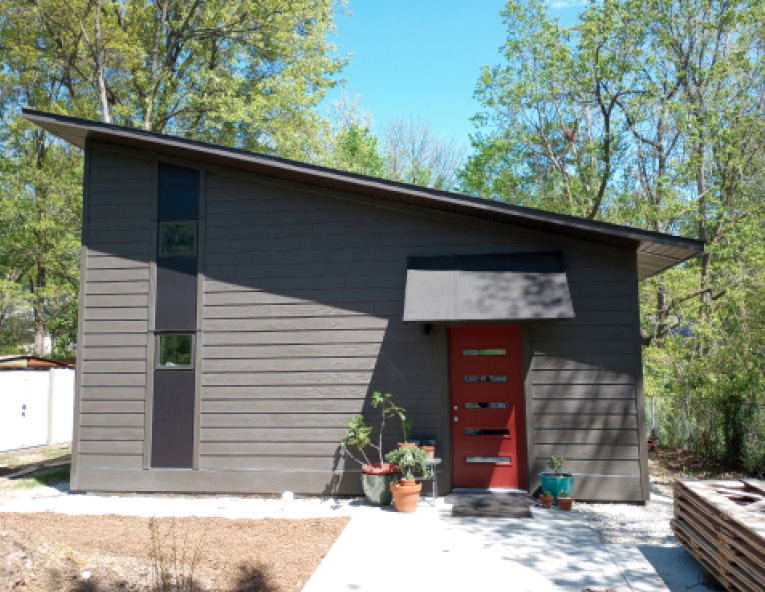
Adrienne and Adam’s accessory dwelling unit (ADU) in Columbia, Missouri. The more conventional aesthetic of the ADU helps it blends into the neighborhood. Just looking at it, you wouldn’t guess what lies within! Photo courtesy of Adrienne Stolwyk.
After her travels, Adrienne returned to Columbia, got married, had a couple of kids, got her architect license, and started her firm, Monarch Architecture. Along with her husband, Adam, and some friends, Adrienne formed a group called Enhancing Columbia’s Housing Options (ECHO), which successfully lobbied the City of Columbia to adopt an accessory dwelling unit ordinance in 2014. The ordinance was passed as a pilot program, making just two or three thousand lots in the city of Columbia eligible for backyard ADUs. Adrienne hopes this will be a first step towards a more widespread acceptance of ADUs. At last, in 2020, Adrienne and Adam broke ground on a straw cell* ADU in their backyard.
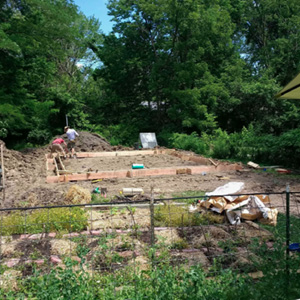

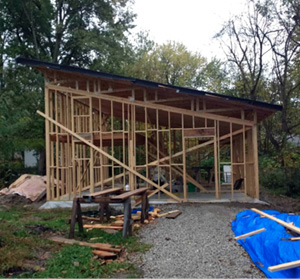
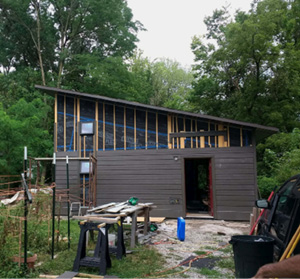
Progress over time. After the ADU’s exterior was complete, work began inside on straw bale installation and plastering. Photos courtesy of Adrienne Stolwyk.
Tommy Fieser is a natural builder in Columbia, Missouri. He was hired as the subcontractor for Adrienne’s ADU. Tommy was first introduced to natural building in an Expanding Environmental Consciousness course he took during his undergraduate studies at Truman State University. His class visited the Possibility Alliance, the same intentional community that Adrienne visited, then located near La Plata, Missouri. During his visit and subsequent volunteering in the community, Tommy began to ponder how natural architecture varied across the nation. Earthships* and Pueblo-style homes populate the drier climates of the Southwest, while straw bale houses are more common in the Midwest, where cold winters and humid conditions demand robust insulation and breathable materials. He researched the varied building traditions of Native Americans. Like Adrienne, he traveled to various communities in the US known for their natural buildings. He marveled that, in every place he visited or read about, natural building styles differed according to climate and availability of resources. It happens that in Missouri, the place Tommy calls home, straw bale seems to be the most popular method, so that is what he has pursued most.
JF: How does the ADU compare to other energy efficient architecture?
AS: In my commercial design experience, there was emphasis on air tightness, exterior insulation, different mechanical systems, building orientation, and other energy-efficient techniques. However, there was never much thought put into the types of materials selected. I have come to value safer, carbon-sequestering building materials that will some day decompose, in place of the carbon-demanding materials used in conventional buildings, like steel and cement.
JF: How has regulation regarding straw bale construction changed over the past several years?
AS: Ten years ago, people would have to find an architect or structural engineer who knew something about straw bale and prove to their city’s building department that straw bale construction was legitimate. However, as of 2015, the International Residential Code has included an appendix—Appendix AS—that says if you want to build with straw bale, here’s how you have to do it. In other words, if you meet all the criteria in the appendix, you’re good. That appendix was born of decades of research and legitimizing straw bale construction. Now, because of Appendix AS, anybody can lobby their local authorities to adopt its standards, making it easier than before to build a straw bale house within city limits.
JF: What kind of obstacles would a homeowner likely encounter in building a straw cell ADU?
AS: First of all, the financing is tricky. Banks lend money for single family homes all the time, but are more hesitant to do so for atypical constructions like straw cell ADUs. We did a lot of the work ourselves, and the total cost of our ADU with solar panels came out to be about $115,000. Even though it can be tricky, it isn’t impossible to finance this type of project. Second, in most cases, the homeowner essentially must become a general contractor for their ADU, and that is a huge undertaking. Sometimes, even if the homeowner has realized that their lot is eligible for an ADU, they might not be in a position to apply for financing. Between those two things -the difficulty of financing and the scale of the project—I’m not surprised that not that many ADUs have been constructed.
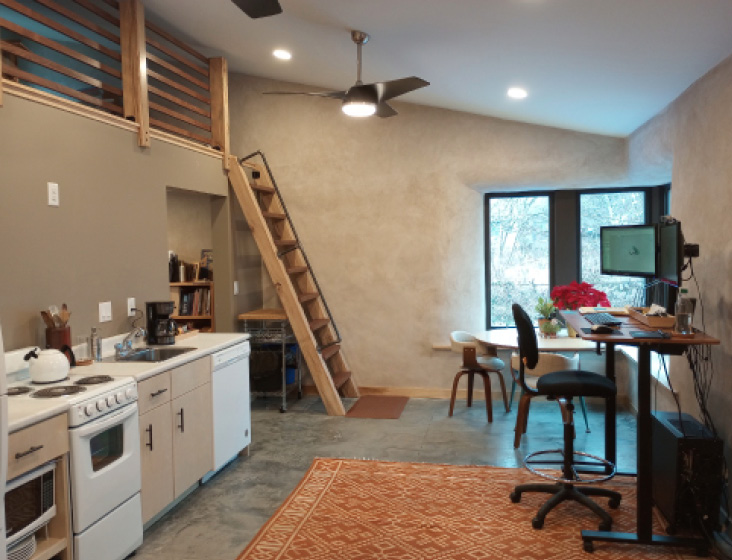
A look inside: the interior of Adrienne and Adam’s straw cell ADU. The house consists of a bathroom, open kitchen/dining room/office space, bedroom, and storage loft. Photo courtesy of Adrienne Stolwyk.
JF: How could your straw cell house be improved?
AS: I’m trying to figure out how to more easily maintain natural structures. In my backyard house, sometimes little bits of sand slough off. Better plastering methods could minimize this, but it’s not really a problem for me. Still, I imagine a situation in which young kids are hard on the walls, maybe coloring on them with crayon. In a conventional house, you can just spackle and paint over such damage and it’s fine. With a natural building, you can certainly fill gaps and holes, but finishing isn’t as easy as putting a coat of latex paint on it. Latex paint messes with the vapor profile, potentially trapping moisture in the wall and creating conditions prone to rot. Thus, I’m figuring out a way to combine straw cell construction with gypsum board or some other conventional inter- ior material that is easier to repair and paint.
JF: Why are you interested in net zero straw bale housing?
TF: The two main ways we impact and interact with our environment are our food and housing systems. I enjoy gardening, but I’m more drawn to the latter. I know a lot of people who farm and garden, so I feel as though natural housing is the least emphasized, at least in my community. There is a lot of work to be done to get natural buildings to a state fit for our urban Missouri environment. Specifically, more straw bale sample houses need to be built to increase awareness that they are a viable option for in-town building.
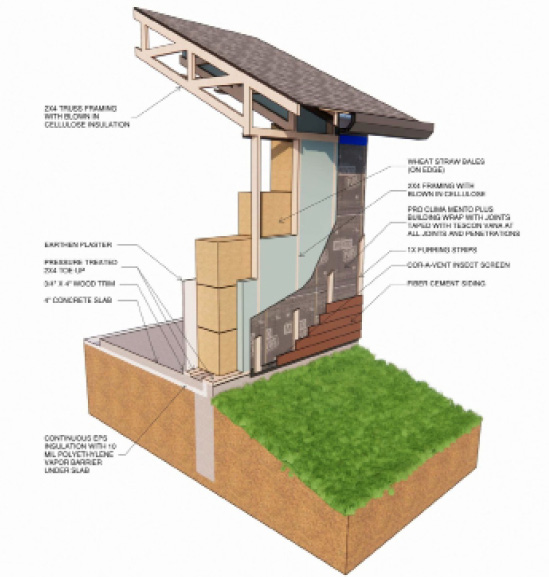
Cross-sectional diagram of the exterior of the straw cell ADU. The pressure-treated toe-up protects the straw bales from moisture and rot. Courtesy of Monarch Architecture.
JF: Why build net zero straw bale houses?
TF: The net zero straw bale housing modelled in Adrienne’s ADU is desirable because it is tight, insulated, and thermally massive. These three characteristics work together to use energy very efficiently. If you have a good thermal shell from the outside environment, like you get when you combine airtightness, insulation, and thermal mass, then you don’t need to use your air conditioner or heater as much to maintain a comfortable living environment. (See the “Ask Tommy” sidebar for a deeper dive into these terms.)
JF: What is an energy recovery unit and how does it work?
TF: An energy recovery unit provides fresh air while making the most of energy used for heating and cooling. In Adrienne’s house, there are two energy recovery units, controlled by electricity and located in opposite walls. One brings air into the house while the other pushes air out, and they switch directions every five minutes. In essence, an energy recovery unit consists of a fan surrounded by rock. As the air that is conditioned inside (i.e., warmed or cooled by a heater, stove, or AC) moves outside, the rocks take on the temperature of the outgoing air. When the fans switch directions, fresh air from outside passes over these rocks that are conditioned to the house’s internal temperature. Thus, the house is filled with fresh air from outside that is conditioned by the air that was inside. In other words, the unit recovers the energy used by your heater or AC from outgoing air and uses it to condition incoming air. This cuts down on overall energy use.
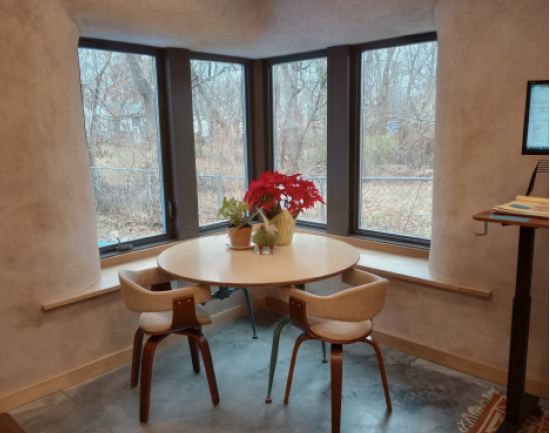
A close-up of the dining area. Note the insulative, thermally massive straw bale walls, most apparent in the window well. Photo courtesy of Adrienne Stolwyk.
JF: Why build an ADU?
AS: ADUs aren’t the only solution for affordable/workforce housing, and they certainly aren’t the quickest solution, at least not yet. However, they are more of a grassroots solution. Compared to big housing complexes that people typically don’t like in their neighborhoods, ADUs are necessarily smaller, less conspicuous, and don’t drastically change the character of the neighborhood. Relatedly, ADUs create affordable housing in the areas it is needed most. While it’s easier to build on the periphery of a city— fewer constraints, fewer neighbors to complain— affordable housing on the outskirts of a city is not very helpful unless you have a car. If the housing isn’t accessible via public transit or within walking distance of an employer, then it’s not that useful for the people who really need workforce housing.
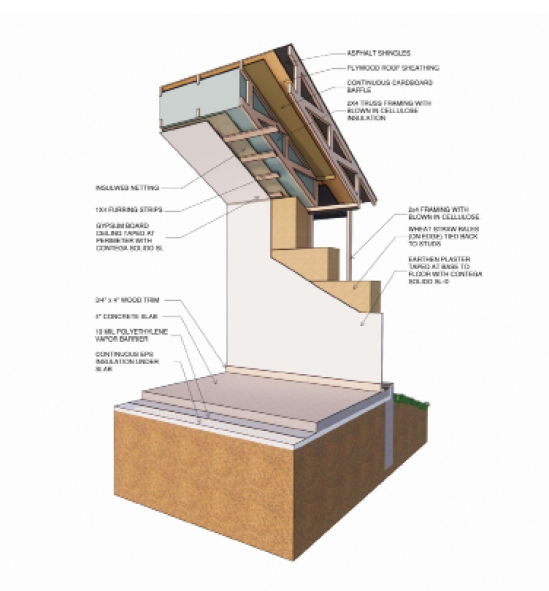
Cross-sectional diagram of the interior of the straw cell ADU. Courtesy of Monarch Architecture.
Additionally, ADUs better enable intergenerational living. Nursing homes and childcare are not affordable for many families in the US. As the “silver tsunami” of baby boomers reaches retirement age, backyard houses may become homes for elderly family members, and those elderly members may offer childcare to busy parents. This system of intergenerational living could offer refreshing social dynamics, especially given the social isolation often experienced in retirement homes. To that end, ADUs lend themselves to ADA accessibility. It is often easier to build a new house than to retrofit an old house to be accessible.
Lastly, ADUs allow more opportunity to experiment with different types of architecture, like straw bale or other forms of natural building. It’s less of a commitment and financial challenge to build a small straw bale house in your backyard than to build a full-sized straw bale house and have it be the only structure on your property.
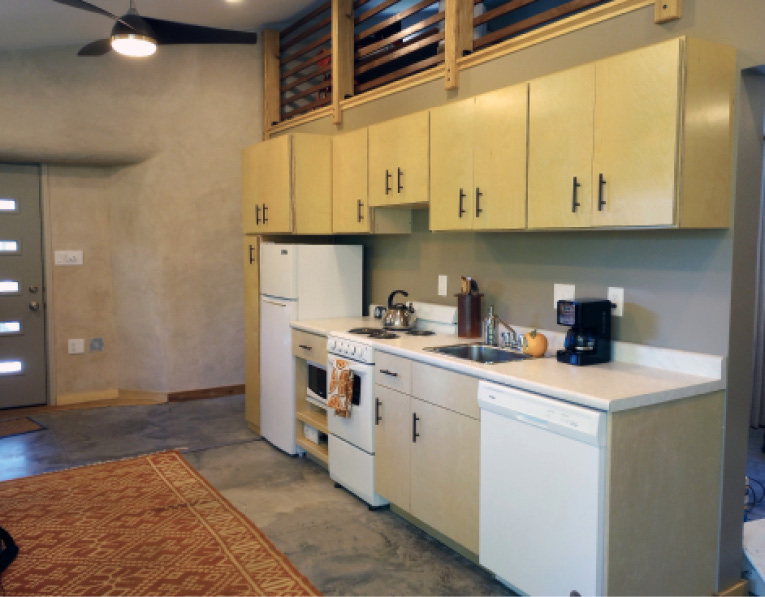
The ADU features a full kitchen with storage. Photo courtesy of Adrienne Stolwyk.
JF: What other ideas do you have on increasing housing accessibility and limiting environmental impact?
AS: I think we need to build more houses, but I don’t think that’s the only solution. In the US, we have a lot of land that’s already been developed, and lots of houses with lots of bedrooms, but we are not using them efficiently, or sometimes even at all. To address the housing shortage, we could better distribute people into the housing stock that already exists.
JF: What are your plans for the future?
AS: Oregon-based ADU expert Kol Peterson said that the next step after constructing some ADUs in your town is to show that ADUs can be a good thing: Parking isn’t creating all sorts of problems, and the character of the neighborhood isn’t ruined by a couple of little backyard houses that aren’t even visible from the street. After you get some good press, then you can push the regulations a bit more. With this advice in mind, I’m hosting an open house next month. It will include my house and four other ADUs in the area. In the long term, I would like to advocate for a Missouri state law allowing accessory dwelling units to be built in any residential zone. In 2020, California passed a similar law. I think that that could be a really powerful thing in Missouri.
I think the key to getting more naturally built accessory dwelling units installed on the face of the planet is prefabrication. To my knowledge, few people have attempted straw bale prefabrication on a large scale. I’m excited about prefabrication, but as of now, I can’t see an investor being convinced that I could do ten straw bale houses in a given time frame. We’ll have to start with one prefabricated house, just to show that it is possible. Then, hopefully that will convince people to support more prefabricated straw bale houses.
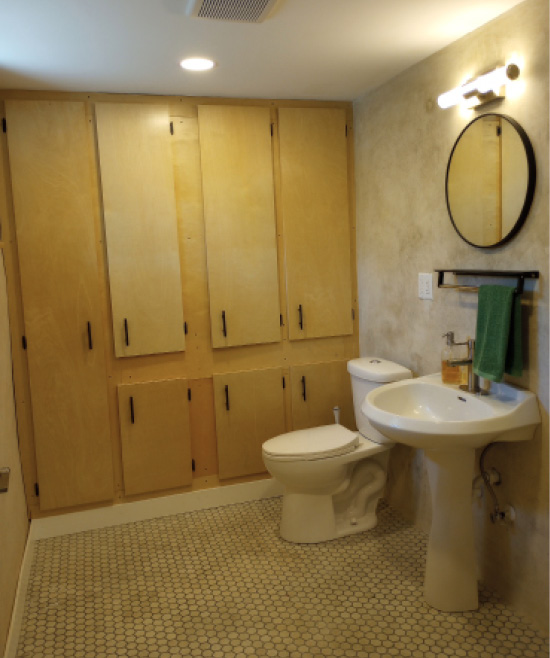
The bathroom in the ADU. Photo courtesy of Adrienne Stolwyk.
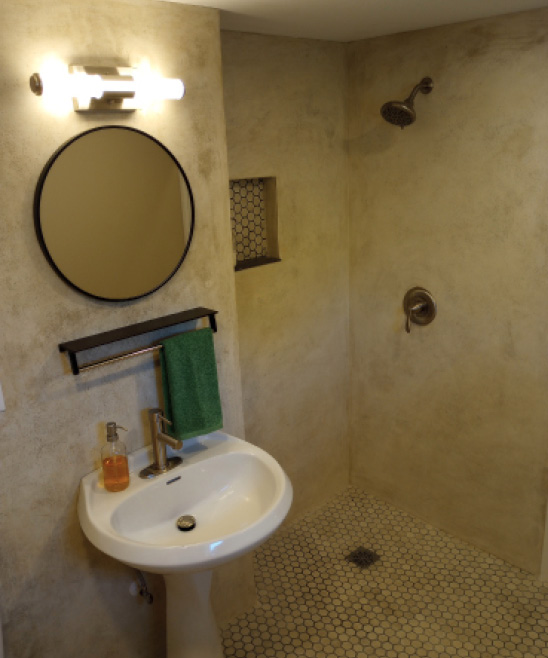
Note the tadelakt* shower wall in the bathroom.Photo courtesy of Adrienne Stolwyk.
Another obstacle in prefabrication is labor. Straw bale construction is very time-consuming and requires many hands. I’m brainstorming ways to hire people for short periods of time to prepare prefabricated walls—maybe we could rent a large, climate-controlled indoor space and hire seasonal workers for a few weeks in the winter, when other work is hard to come by.
TF: Right now, I am focused on another building project with my dad and on running my handyman business. Nonetheless, I continue preparation for my own straw bale house. I’ve been preparing for about four years now, but each year has brought a lot of helpful knowledge. I have a lot in Columbia that I plan to build on, and have already planted some pawpaws, elderberries, and persimmons there. I want to use as many repurposed materials as possible, so that is an ongoing collection. I’ll be documenting the whole process on my YouTube channel, Tommy Tommy Fieser, because I think it is important to share my knowledge and process with people. Straw bale is something worth talking about!
Ask Tommy: What Does “Tight, Insulated and Thermallly Massive” Mean?
By tight, I mean airtight. Imagine you build an igloo with plenty of insulation and thermal mass, but you don’t fill in the cracks. It will be drafty, not airtight. All that insulation is worth little if cold air can seep in through the cracks. In a straw bale house, airtightness must be balanced with the necessity of the straw bales in the wall to “breathe”. If you cover a straw bale in a vapor impermeable material, like plastic or concrete, it will mold and ruin the wall. Rather, you must cover the bales in a breathable material like clay plaster. Moisture can still go in, but it can also go out. If a bale gets wet, it’s okay because it can dry. Airtightness saves energy because unconditioned outside air is forced through the thermally massive insulation or energy recovery unit instead of just seeping through the cracks.
Insulation is important for obvious reasons, especially here in the Midwest where the temperature swings can be large. For example, 30 degrees to 70 degrees over the course of a day is fairly common. Insulation creates an internal environment that is buffered from the outside, making it so the temperature inside remains stable despite changes outside. The building code requires walls with an R-value* of 13 or 15. For reference, a blow-up camping mattress is typically around R-4. If you put three or four of those camping mattresses together, you would get the equivalent insulation of a conventional wall. By contrast, straw bale walls are often at least 17 inches thick and have an R-value of around 30. Furthermore, straw bales serve as a natural insulator that stores carbon in the form of organic matter. Thermally broken* slabs are also useful.
Thermal mass has to do with the heat capacity* of a material. In a variable environment like the Midwest, you want high heat capacity insulation. Dense materials like clay, rock, and water have high heat capacities and thermal mass, maintaining their temperature even as conditions change. If you open the door of your cozy house in winter, you’ll let all your warm air escape. But, if you build with thermally massive materials, your walls and floor will store heat, which will diffuse into the room even after you open the door and thus rebalance the internal temperature of the house without extra energy use.
Glossary
Accessory Dwelling Unit (ADU): Independent housing units created within single-family homes or on their lots. Also referred to as a mother-in-law house or backyard house. 1
Carbon-sequestering: A term to describe materials (such as plant tissue) that store carbon captured from the atmosphere. Carbon dioxide in the atmosphere is a major culprit of the greenhouse effect and climate change. Like all plants, members of the grass family assimilate carbon as they grow. Therefore, when that straw made from grasses is used in straw bale construction, the carbon is stored within the walls for the lifetime of the building. In this way, straw bale construction sequesters carbon and thereby helps to reduce the amount of carbon in the atmosphere that contributes to climate change. 2
Earthship: Any of several passive solar* houses based on the designs of New Mexican architect Michael Reynolds 3
Heat capacity: The amount of energy it takes to raise the temperature of a substance by 1°C . In other words, heat capacity is the substance’s ability to resist change in temperature upon exposure to a heat source. A substance with a small heat capacity cannot hold much heat energy and thus warms up quickly. On the other hand, a substance with a high heat capacity can absorb much more heat without its temperature drastically increasing. 4
Natural building: Alternative building methodology that uses natural materials in place of conventional man-made materials like cement and steel.
Net zero home: A residential structure with an annual net-energy consumption of zero; a home that produces (e.g. with solar panels) as much energy as it uses annually. 5
Passive solar: An architectural design that uses the sun’s energy for heating and light without energy. 6
R-value: A unit of thermal resistance used for comparing insulating values of different materials; the higher the R-value, the greater its insulating properties. 2
Straw-bale construction: Natural building method featuring bales of straw in place of standard construction materials for structural elements and/or insulation. 7
Straw cell: A type of straw bale construction featuring conventionally framed walls with cellulose insulation in the stud cavity and plastered straw bales on the interior. 8
Tadelakt: A decorative, seamless, waterproof, lime-based plastering surface used as an alternative to tile and often used in bathrooms. Sometimes called Moroccan plaster, this is a traditional technique in the Marrakesh region of Morocco. 9
Thermally broken: A construction featuring thermal breaks; that is, materials that conduct energy poorly, thereby reducing the flow of thermal energy between conductive materials. Thermal breaks help prevent heat from escaping a building. 10
1 https://www.como.gov/Council/Commissions/downloadfile.php?id=8255
2 https://theecologist.org/2012/apr/20/are-straw-bales-future-sustainable-building
4 https://chem.libretexts.org/Courses/University_of_Arkansas_Little_Rock/Chem_1402%3A_General_Chemistry_1_(Kattoum)/Text/5%3A_Energy_and_Chemical_Reactions/5.2_Specific_Heat_Capacity
5 https://www.squareone.ca/resource-centres/homeowner/what-are-net-zero-or-net-energy-homes#:~:text=A%20Net-zero%20home%20is%20a%20home%20built%20with,doesn%E2%80%99t%20necessarily%20mean%20that%20Net-zero%20homes%20are%20off-grid.
6 https://www.techtarget.com/whatis/definition/passive-solar#:~:text=Passive%20solar%20is%20the%20use%20of%20the%20sun%E2%80%99s,gathering%20or%20transformation%20through%20mechanical%20or%20electronic%20means.
7 https://www.greenbuilt.org/articles/156-green-building-glossary/
8 https://monarch-architecture.com/portfolio/sustainable-accessory-dwelling/
10 https://echotape.com/construction-and-insulation/why-thermal-bridging-and-thermal-breaks-matter-in-construction/
